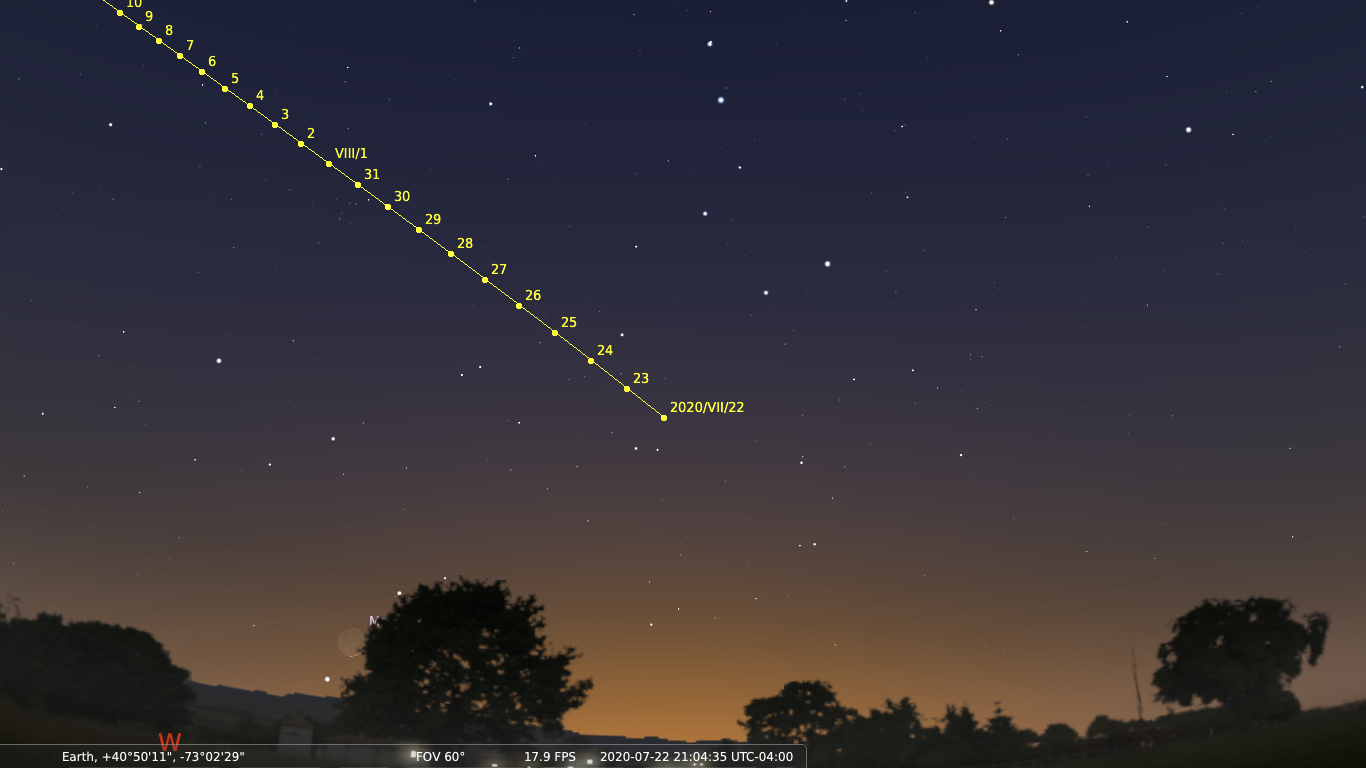Update (22 July, 2020)
As of today’s date, Comet 2020 F3 NeoWise rises with the sun and is thus, exclusively an evening object. The comet is well placed at twilight, south and west of Merak and Dubhe, the famous “pointer stars” of the “Big Dipper“, the Northern-Hemisphere asterism made famous as a great “dipper” in the sky. These stars “point” to Polaris if a line connecting them is continued (see illustration below).
For an interactive experience and to follow the path of Comet 2020 NeoWise, why not try out our new “Night Sky via Stellarium-web” portal.
Discovered in late March, Comet 2020 F3 Neowise brightened as it reached its closest approach to the Sun, inside the orbit of Mercury, on July 3rd. It’s visible both as an evening object after July 16th and as an early morning object now.

The path of Comet 2020 F3 NeoWise as viewed over the next 2 weeks. As of today’s date, as suggested by this illustration, the comet is still lost in the setting sun’s glare and won’t be visible to evening observers until July 16th. Image produced using Stellarium (v 0.20.2).
As it continues its outbound trajectory, having rounded the sun on July 3rd, Comet 2020 F3 NeoWise will gradually fade through July and, prior to July 16th, is lost in the setting sun’s glare. On that date, it will still be will above the naked-eye visual threshold (magnitude 6) and is well positioned for visual observation. A pair of binoculars would be the best method to observe the comet and it’s twin tails.
If you’re an early riser and would prefer to observe the comet in the predawn hours now, the following illustration depicts the position of the comet in the early-morning hours starting this morning (July 10). It’s brightness, which is largely based on its distance from the sun, is well above the visual threshold (magnitude 6.0); optimal observations of the comet’s twin tails and their details would require a pair of binoculars or a telescope.
Unnarrated video of Comet 2020 F3 NeoWise over the next 2 weeks as an evening and morning object. Also included in the video are stunning morning views of the waning crescent moon, Venus (in Taurus and close to the Red Giant Star Aldebaran) and Mercury all followed by the morning sunrise.
Featured Image(s)
The Two Tails of Comet 2020 NeoWise
The comet’s developing tails stretch some six degrees across this telescopic field of view, recorded from Brno, Czech Republic before daybreak on July 10. Pushed out by the pressure of sunlight itself, the comet’s broad, yellowish dust tail is easiest to see. But the image also captures a fainter, more bluish tail too, separate from the reflective comet dust. The fainter tail is an ion tail, formed as ions from the cometary coma are dragged outward by magnetic fields in the solar wind and fluoresce in the sunlight. In this sharp portrait of our new visitor from the outer Solar System, the tails of comet NEOWISE are reminiscent of the even brighter tails of Hale Bopp, the Great Comet of 1997.
Comet 2020 F3 NeoWise as observed from the International Space Station
Rounding the Sun on July 3rd and currently headed for the outer Solar System, Comet NEOWISE (C/2020 F3) has been growing brighter in the predawn skies of planet Earth. From low Earth orbit it also rises before the Sun, captured above the approaching glow along the eastern horizon in this view from the International Space Station on July 5. Venus, now Earth’s morning star is the brilliant celestial beacon on the right in the field of view. Above Venus you can spot the sister stars of the more compact Pleiades cluster. Observers can spot this comet with the unaided eye, but should look for awesome views with binoculars.
Imagination is more important than knowledge
![]()
An index of all articles can be found here.
If you enjoyed this article, please consider supporting us with a modest donation
or through a subscription on our Patreon Page
Membership at Astronomy for Change is Free!
Unique visits–>







